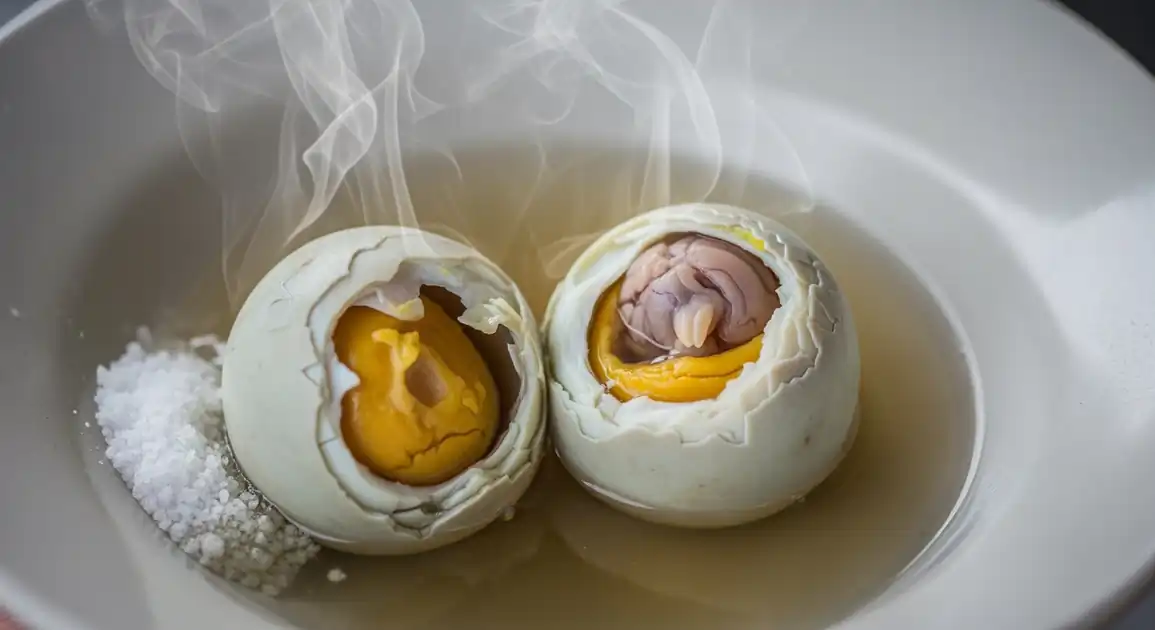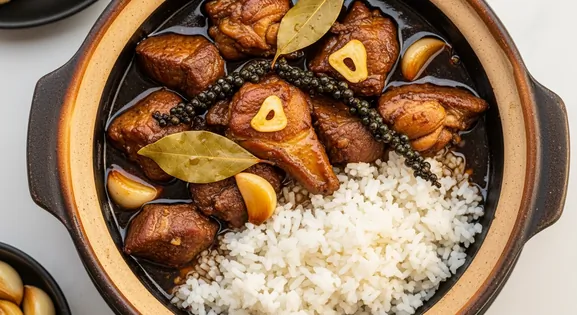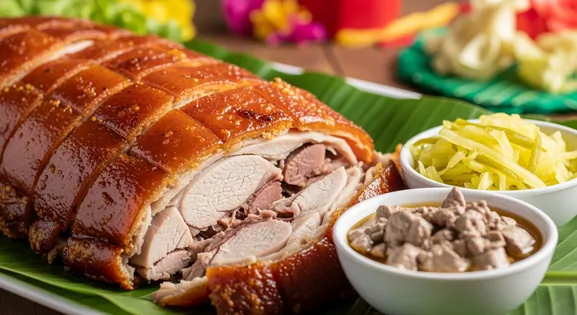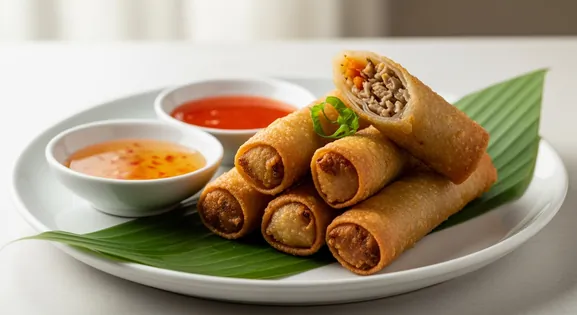Balut (Fertilized Duck Egg) in Manila
Balut

A Guide to the Local Experience
Stepping into Manila's vibrant night, the call of 'Baluuut!' is an unmistakable invitation. This iconic fertilized duck egg, a true Filipino delicacy, offers a unique culinary adventure. Embrace the local spirit and discover why Balut is more than just food—it's a cultural rite of passage in the bustling capital.
New to Balut (Fertilized Duck Egg)? Learn all about its history in our complete guide.
Insider Tips for Balut (Fertilized Duck Egg)
Before peeling, gently crack the top of the egg and sip the savory broth inside. This flavorful liquid is considered a delicacy by many locals and is an essential part of the Balut experience.
Always ask for spiced vinegar ('suka') and rock salt ('asin'). These condiments perfectly complement the rich flavor of the Balut, cutting through its richness and adding a tangy kick.
While fixed stalls exist, the most authentic experience often comes from mobile vendors who roam residential streets and busy intersections, calling out 'Baluuut!' Their eggs are usually freshly cooked and hot.
Where to Find Balut (Fertilized Duck Egg) in Manila
Residential Neighborhoods (e.g., Quezon City, Sampaloc)
Vendors walk routes calling out 'Balut'. High chance of finding them here.
Local streets, Small community stores ('sari-sari')
7 PM - 11 PM
University Belts (e.g., near UST, UP Diliman)
These areas are prime spots due to the high concentration of students and residents looking for quick, affordable evening snacks. Vendors often set up near campus gates or popular student hangouts.
University campuses, Nearby eateries
Evening, Night
Busy Intersections / Transport Stops
With constant pedestrian flow, these locations are ideal for vendors to catch commuters heading home or waiting for rides. Look for them near major public transport hubs.
Jeepney/bus stops, LRT/MRT station surroundings
Evening, Night
Makati / BGC (near nightlife)
Vendors may appear later in the evening catering to crowds leaving bars/restaurants.
Poblacion (Makati), Bonifacio High Street vicinity (BGC)
Late Night (10 PM onwards)
Vendor Tips
- Be ready with small bills/coins.
- Confirm the price before agreeing ('Magkano po?').
- If unsure, observe where locals are buying from.
- Vendors are mobile, so walk around likely areas if you don't see one immediately.
Authentic vs Imitation: The Telltale Signs
What to Look For
-
Vendors actively selling in the evening/night, often calling out 'Baluuut!' in residential areas or near transport hubs (e.g., Pasay Rotonda, EDSA).
Indicates fresh, recently cooked batches meant for immediate consumption.
-
Eggs kept demonstrably warm/hot inside insulated containers (styrofoam boxes, cloth-lined baskets). Ask to feel the egg ('Painitin po muna').
Consistent warmth is a key quality indicator. Prioritize vendors who maintain the eggs at a consistently hot temperature for optimal enjoyment.
-
Eggs that are intact without significant cracks before purchase.
An uncracked shell helps maintain the egg's integrity and quality, ensuring a better experience when consuming this street food.
-
Vendors who appear clean and handle eggs with care.
A vendor's overall cleanliness and careful handling practices are good signs of attention to product quality.
What to avoid
-
Balut sold during the daytime, or eggs that feel cool or room temperature.
Must be consumed hot/warm. Avoid if not kept heated.
-
Eggs with large cracks or visible damage.
Compromised shells can affect the overall quality and enjoyment of the balut, so it's best to select intact eggs.
-
Vendors selling in very dirty locations or handling money and eggs without washing hands/using barriers.
Observe vendor hygiene; clean practices contribute to a more pleasant and reliable street food experience.
-
'Penoy' eggs (unfertilized eggs cooked similarly) being passed off as Balut if you specifically want Balut. Penoy is a different product if Balut seems too challenging.
Understand the difference between Balut and Penoy; Penoy is an unfertilized egg, offering a milder introduction to this type of street food.
The Traveler's Essentials
Dietary Information
Important Note for Travelers: Your safety is our priority. Below are the common allergens associated with the traditional preparation of this dish. However, recipes and ingredients can vary significantly between establishments. Always confirm all ingredients directly with the food vendor before ordering, especially if you have a severe allergy.
Potential Allergens
Dietary Suitability
Price Guide
Budget Tips
- Prices might be slightly higher in central business districts (Makati, BGC) compared to residential areas (e.g., Quezon City, Pasay).
- Street vendors offer the standard price; restaurants mark up significantly.
- Look for vendors where locals are buying.
Serving & Seasonality
Classic street style: warm egg, salt, spiced vinegar, eaten by hand.Best Times to Enjoy
- Evening: Vendors become very active from 6 PM onwards across the city.
- Night: Prime time, especially near nightlife spots or residential areas (9 PM - 2 AM).
Seasonal Availability
Year-round.
How to Order with Confidence
When ordering Balut in Manila, specify your preference for the embryo's development if you have one; 'mura' (younger, less developed) or 'matanda' (older, more developed). Always ask for it 'mainit' (hot) to ensure freshness. Don't forget to ask for rock salt ('asin') and spiced vinegar ('suka')—these are essential accompaniments. Observe how locals eat it: crack the top, sip the broth, then peel and eat the contents, often with a pinch of salt.
How Locals Eat It: Variations
Vinegar Spice Level
Vinegar spiciness might vary; some vendors offer milder or spicier options if asked.
Availability of Penoy
Most Balut vendors in Manila will also sell Penoy.
Traditions and Etiquette
Local Significance
Strongly reflects the national significance. A very common sight and sound in Manila's evenings. Integral part of the urban street food scene.
Eating Customs
- Standard Filipino way: Sip broth, season, eat contents.
- Consumed quickly and informally.
Practical How-To Guides
Where and When to Find Balut Vendors in Metro Manila
Learn the best strategies to locate Balut vendors across Manila's diverse neighborhoods and understand their typical operating hours for a successful street food hunt.
- Listen for the distinct call of 'Baluuuut!' from vendors walking or biking through residential neighborhoods (like parts of Quezon City, Makati, Pasig) usually from late afternoon into the night (6 PM - midnight).
- Check near bus terminals, jeepney stops, or LRT/MRT stations in the evening, where vendors often cater to commuters (e.g., Monumento, Cubao, Pasay Rotonda).
- Look for small stalls or individual vendors with baskets/coolers near night markets or busy street corners.
- Balut is primarily an evening/night snack, rarely sold fresh in the morning.
- Ask tricycle drivers or local store owners ('Saan po may naglalako ng balut?') if searching in a specific area.
How to Ask for Your Preferred Balut Age in Manila
Navigate the nuances of ordering Balut by understanding how to express your preference for the egg's developmental stage, enhancing your authentic Manila street food experience.
- Vendors often carry eggs of slightly different ages. 'Balut sa puti' (wrapped in white) sometimes implies a younger egg (around 16 days), though not a strict rule.
- You can ask for 'Mura pa po ba?' (Is it still young?) or specify day count if you know ('Mga 16 days po sana').
- 'Mas sisiw' means more developed embryo, 'mas sabaw' might imply slightly younger/more broth.
- Be aware that vendors might just sell what they have, typically around 17-18 days.
- For beginners, slightly younger (16-17 days) might be less challenging.
Our Commitment to Quality
At Tasteplorers, our mission is to provide the most accurate and useful travel information in the world. To achieve this, all content on this site is created through our unique editorial framework. We utilize leading AI research tools, guided by our proprietary prompts, and a multi-stage validation process. This entire system is overseen by our editorial team to ensure everything we publish meets our high standards for accuracy, cultural nuance, and practical value for travelers.
Learn more about our Editorial Process and our Mission.
Countries
Explore regions
Europe
Discover Europe's diverse culinary landscape, from Mediterranean flavors to hearty Alpine fare. Learn to navigate markets, decode menus, and eat like a local.
Latin America & Caribbean
Discover the vibrant cuisines of Latin America & the Caribbean. Our expert guide covers everything from Mexican street food to Peruvian ceviche and market tips.
Oceania
Explore Oceania's diverse food scene. Learn about Polynesian earth ovens, Fijian feasts, and the vibrant café culture of Australia and New Zealand.
Southeast Asia
Explore Southeast Asia's diverse food cultures from Thailand to Vietnam. Get expert tips on navigating spice levels, choosing quality vendors, and understanding the rich traditions of the region.



